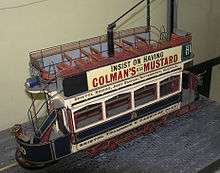Bristol Tramways
 The Tramways Centre | |
| Locale | England |
|---|---|
| Dates of operation | 1875–1941 |
| Headquarters | Bristol |

Bristol tramways were operated from 1875, when the Bristol Tramways Company was formed by Sir George White, until 1941 when a Luftwaffe bomb destroyed the main power supply cables.
History
The first trams in Bristol (horse-drawn, with a maximum speed of 6 miles per hour) were introduced in 1875. Electric trams were introduced in 1895, the first city to do so in the United Kingdom. At its peak there were 17 routes and 237 tramcars in use.
In 1887 the Bristol Tramways Company merged with the Bristol Cab Company to form the Bristol Tramways and Carriage Company. The new company developed a fleet of omnibuses to serve the rest of the city and country areas. In 1912 it bought the Clifton Rocks Railway. In 1929 the White family sold its controlling interest in the company to the Great Western Railway, but by 1932 control had passed to the Thomas Tilling Group. William Verdon Smith (nephew of Sir George White) remained as chairman but was replaced in 1935 by J.F. Heaton of Thomas Tilling, so he could concentrate on the Bristol Aeroplane Company.
In 1937 control of Bristol's tramways passed to a joint committee of the Bristol Tramways company and Bristol Corporation.
Closure
Abandonment of the tramways began in 1938, but this was halted at the outbreak of World War II. Tram operations ceased in 1941 with the Luftwaffe's Good Friday raid, which set central Bristol on fire. A bomb hit Counterslip bridge, St Philips, next to the Tramways generating centre, and severed the tram power supply. The final tram from Old Market to Kingswood was given a push by passers-by and freewheeled its way into the depot.
Almost all Bristol's trams were scrapped; however, one is preserved by the Bristol Aero Collection which closed its museum at Kemble in May 2012 but expects to re-open in due course at Filton, Bristol.[1] Another memorial to the system is a length of tram track still embedded in St Mary Redcliffe churchyard, where it was blown by a bomb. Two lengths of intact track can be seen at the car park of the Gloucester Road Medical Centre, and a short section of track still exists on the approach to Temple Meads railway station. Another section of track used to be still in place near Castle Park, but this was lost when the area was redeveloped as part of the Cabot Circus development.
The Bristol Tramways company continued as a bus operator, but the name was not changed to Bristol Omnibus Company until 1957.
Routes
| Bristol Tramways | |||||||||||||||||||||||||||||||||||||||||||||||||||||||||||||||||||||||||||||||||||||||||||||||||||||||||||||||||||||||||||||||||||||||||||||||||||||||||||||||||||||||||||||||||||||||||||||||||||||||||||||||||||||||||||||||||||||||||||||||||||||||||||||||||||||||||||||||||||||||||||||||||||||||||||||||||||||||||||||||||||||||||||||||||||||||||||||||||||||||||||||||||||||||||||||||||||||||||||||||||||||||||||||||||||||||||||||||||||||||||||||||||||||||||||||||||||||||||||||||||||||||||||||||||||||||||||||||||||||||||||||||||||||||||||||||||||||||||||||||||||||||||||||||||||||||||||||||||||||||||||||||||||||||||||||||||||||||||||||||||||||||||||||||||||||||||||||||||||||||||||||||||||||||||||||||||||||||||||||||||||||||||||||||||||||||||||||||||||||||||||||||||||||||||||||||||||||||||||||||||||||||||||||||||||||||||||||||||
|---|---|---|---|---|---|---|---|---|---|---|---|---|---|---|---|---|---|---|---|---|---|---|---|---|---|---|---|---|---|---|---|---|---|---|---|---|---|---|---|---|---|---|---|---|---|---|---|---|---|---|---|---|---|---|---|---|---|---|---|---|---|---|---|---|---|---|---|---|---|---|---|---|---|---|---|---|---|---|---|---|---|---|---|---|---|---|---|---|---|---|---|---|---|---|---|---|---|---|---|---|---|---|---|---|---|---|---|---|---|---|---|---|---|---|---|---|---|---|---|---|---|---|---|---|---|---|---|---|---|---|---|---|---|---|---|---|---|---|---|---|---|---|---|---|---|---|---|---|---|---|---|---|---|---|---|---|---|---|---|---|---|---|---|---|---|---|---|---|---|---|---|---|---|---|---|---|---|---|---|---|---|---|---|---|---|---|---|---|---|---|---|---|---|---|---|---|---|---|---|---|---|---|---|---|---|---|---|---|---|---|---|---|---|---|---|---|---|---|---|---|---|---|---|---|---|---|---|---|---|---|---|---|---|---|---|---|---|---|---|---|---|---|---|---|---|---|---|---|---|---|---|---|---|---|---|---|---|---|---|---|---|---|---|---|---|---|---|---|---|---|---|---|---|---|---|---|---|---|---|---|---|---|---|---|---|---|---|---|---|---|---|---|---|---|---|---|---|---|---|---|---|---|---|---|---|---|---|---|---|---|---|---|---|---|---|---|---|---|---|---|---|---|---|---|---|---|---|---|---|---|---|---|---|---|---|---|---|---|---|---|---|---|---|---|---|---|---|---|---|---|---|---|---|---|---|---|---|---|---|---|---|---|---|---|---|---|---|---|---|---|---|---|---|---|---|---|---|---|---|---|---|---|---|---|---|---|---|---|---|---|---|---|---|---|---|---|---|---|---|---|---|---|---|---|---|---|---|---|---|---|---|---|---|---|---|---|---|---|---|---|---|---|---|---|---|---|---|---|---|---|---|---|---|---|---|---|---|---|---|---|---|---|---|---|---|---|---|---|---|---|---|---|---|---|---|---|---|---|---|---|---|---|---|---|---|---|---|---|---|---|---|---|---|---|---|---|---|---|---|---|---|---|---|---|---|---|---|---|---|---|---|---|---|---|---|---|---|---|---|---|---|---|---|---|---|---|---|---|---|---|---|---|---|---|---|---|---|---|---|---|---|---|---|---|---|---|---|---|---|---|---|---|---|---|---|---|---|---|---|---|---|---|---|---|---|---|---|---|---|---|---|---|---|---|---|---|---|---|---|---|---|---|---|---|---|---|---|---|---|---|---|---|---|---|---|---|---|---|---|---|---|---|---|---|---|---|---|---|---|---|---|---|---|---|---|---|---|---|---|---|---|---|---|---|---|---|---|---|---|---|---|---|---|---|---|---|---|---|---|---|---|---|---|---|---|---|---|---|---|---|---|---|---|---|---|---|---|---|---|---|---|---|---|---|---|---|---|---|---|---|---|---|---|---|---|---|---|---|---|---|---|---|---|---|---|---|---|---|---|---|---|---|---|---|---|---|---|---|---|---|---|---|---|---|---|---|---|---|---|---|---|---|---|---|---|---|---|---|---|---|---|---|---|---|---|---|---|---|---|---|---|---|---|---|---|---|---|---|---|---|---|---|---|---|---|---|---|---|---|---|---|---|---|---|---|---|---|---|---|---|---|---|---|---|---|---|---|---|---|---|---|---|---|---|---|---|---|---|---|---|---|---|---|---|---|---|---|---|---|---|---|---|---|---|---|---|---|---|---|---|---|---|---|---|---|---|---|---|---|---|---|---|---|---|---|---|---|---|---|---|---|---|---|---|---|---|---|---|---|---|---|---|---|---|---|---|---|---|---|---|---|---|---|---|---|---|---|---|---|---|---|---|---|
Legend
| |||||||||||||||||||||||||||||||||||||||||||||||||||||||||||||||||||||||||||||||||||||||||||||||||||||||||||||||||||||||||||||||||||||||||||||||||||||||||||||||||||||||||||||||||||||||||||||||||||||||||||||||||||||||||||||||||||||||||||||||||||||||||||||||||||||||||||||||||||||||||||||||||||||||||||||||||||||||||||||||||||||||||||||||||||||||||||||||||||||||||||||||||||||||||||||||||||||||||||||||||||||||||||||||||||||||||||||||||||||||||||||||||||||||||||||||||||||||||||||||||||||||||||||||||||||||||||||||||||||||||||||||||||||||||||||||||||||||||||||||||||||||||||||||||||||||||||||||||||||||||||||||||||||||||||||||||||||||||||||||||||||||||||||||||||||||||||||||||||||||||||||||||||||||||||||||||||||||||||||||||||||||||||||||||||||||||||||||||||||||||||||||||||||||||||||||||||||||||||||||||||||||||||||||||||||||||||||||||
The electric tram routes were not numbered until November 1913. They were then numbered as follows:[2]
- 1. Tramways Centre – Whiteladies Road – Durdham Downs
- 2. Tramways Centre – Whiteladies Road – Durdham Downs – Westbury
- 3. Eastville – Old Market – Whiteladies Road – Durdham Downs
- 4. Tramways Centre – Zetland Road – Durdham Downs
- 5. Tramways Centre – Ashley Down Road – Horfield Barracks
- 6. Tramways Centre – Ashley Down Road – Horfield Barracks – Filton Park – Filton
- 7. Tramways Centre – Warwick Road – Eastville – Fishponds
- 8. Tramways Centre – Temple Meads Station
- 9. Hotwells – Tramways Centre – Temple Meads Station – Arno's Vale – Depot – Brislington
- 10. Bristol Bridge – Knowle
- 11. Bristol Bridge – Ashton Road
- 12. Bristol Bridge – Bedminster Depot – Bedminster Down
- 13. Tramways Centre – Old Market – St. George – Whiteway Rd – Kingswood
- 14. Zetland Road – Old Market – Eastville – Fishponds – Staple Hill
- 15. Knowle – Bushy Park – Old Market – St. George – Marling Road – Nags Head Hill – Hanham
- 16. Old Market – St George
- 17. Hotwells – Tramways Centre – Temple Meads Station
Note that:
- Route 1 was withdrawn and absorbed into 2.
- Route 8 was withdrawn and absorbed into 9.
- Route 13 for a while, did not run to the Tramways Centre but terminated at Old Market.
- Route 16. was a busy-period route only and was absorbed into 13 and 15.
- Route 17 ran to meet the P and A Campbell steamers and was withdrawn at the same time as Route 8
- Trams did not actually run along Ashley Down Rd., Marling Rd., or Whiteway Road, and route 14 did not enter Zetland Rd.
- From 1902 to 1905, the route from Hanham, having reached Old Market, was extended to the Tramways Centre.
References
- ↑ Staff. "Bristol Aero Collection". Bristol Aero Collection. Retrieved 21 April 2013.
- ↑ "Bristol Tramways". South Western Electricity History Society. Retrieved 2 September 2009.
External links
- History of Bristol Tramways
- "BT&CC tram map, 1911". Bristol Vintage Bus Group. Retrieved 2 March 2011.
- The Tramways of Gloucestershire: A Brief History, by A.E. Fielder (1973)
- Potted history of attempts to resurrect trams in Bristol
- History of LTRA development and closure
- Tram routes plotted on Google Maps
- Bristol Tramways at British Tramway Company Badges and Buttons